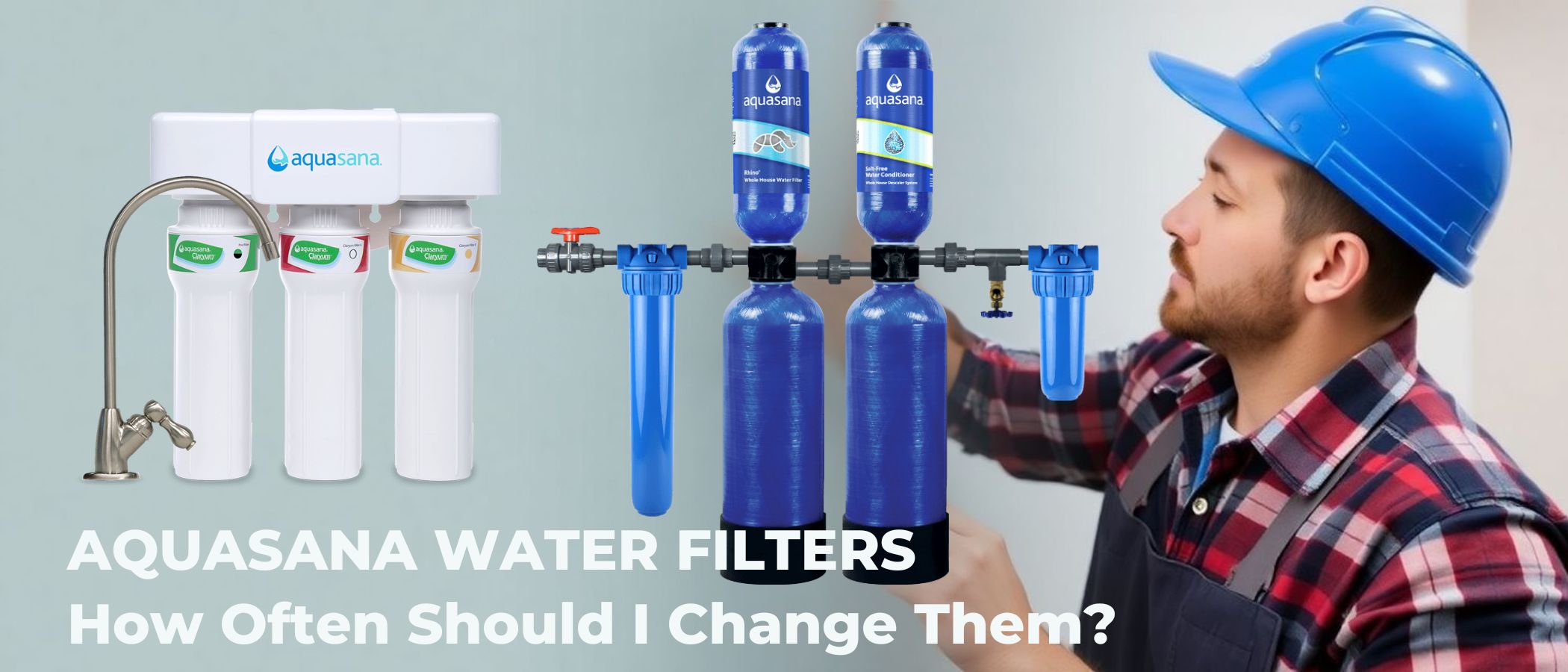Water quality is a critical aspect of our daily lives that often goes unnoticed. As an Aquasana whole-house water filter owner, you’ve taken a significant step towards ensuring clean, safe water for your family. However, maintaining this investment properly is crucial for it’s continued effectiveness.
Filter Replacement Schedule at a Glance
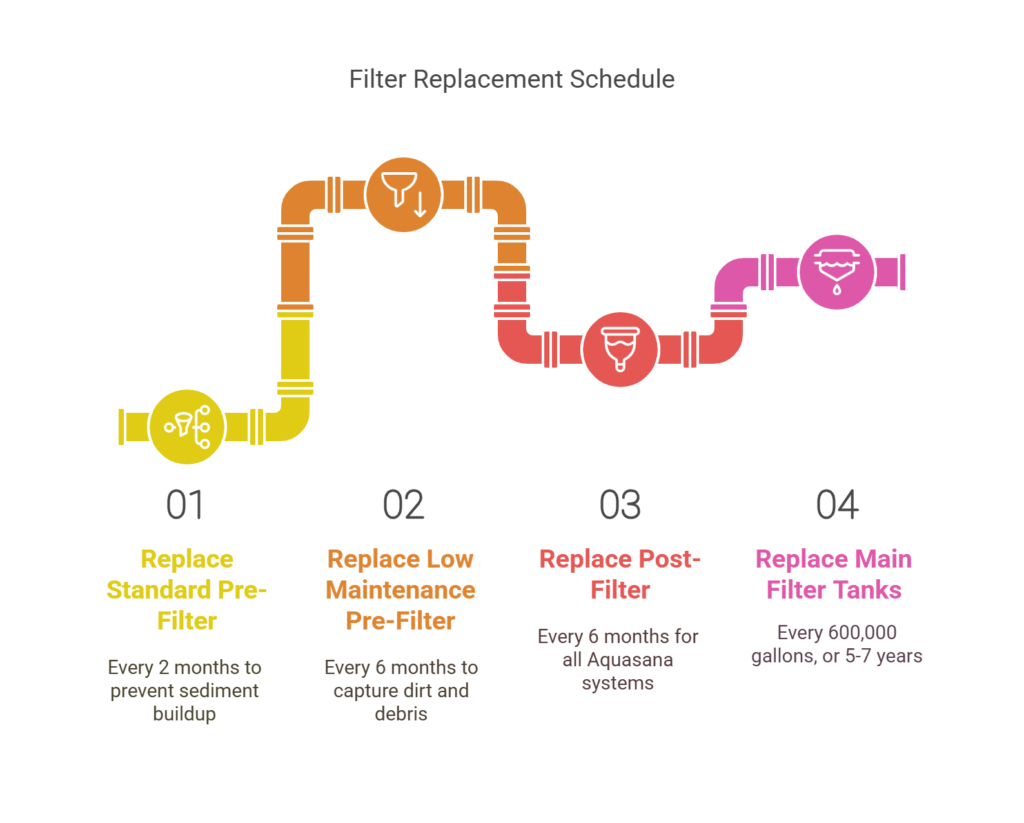
- Pre-Filters:
- Post-Filters:
- Replace every 6 months. This applies to the 10″ Post-Filter used in all Aquasana whole house systems [6].
- Main Filter Tanks:
How Do You Know When a Water Filter Needs Changing?
- If you notice a significant decrease in water flow, it may indicate that a filter needs to be replaced sooner than the recommended schedule [2], [4].
- The frequency of changes may also depend on your household size and water quality; larger households or poorer water quality may necessitate more frequent changes [1].
Regular maintenance is essential to ensure optimal performance and to avoid issues such as bacterial growth or reduced filtration efficacy.
Understanding Your Aquasana System
The Aquasana whole-house water filter system is a comprehensive purification solution designed to remove a wide array of contaminants from your water supply. This system tackles everything from chlorine and sediment to more serious threats like lead and microbial cysts.
Typically, an Aquasana system consists of several key components:
- Pre-filter: This initial stage catches larger particles and sediment, protecting the main filter from premature clogging.
- Main filter: The heart of the system, responsible for removing chlorine, heavy metals, and other contaminants.
- Post-filter: Provides a final polish to your water, ensuring the highest quality output.
Each of these components plays a vital role in the purification process, and each has it’s own lifespan and replacement needs.
The Manufacturer’s Recommendation
Aquasana recommends replacing your filters every six months. This guideline is based on average household water usage and typical water quality conditions.
However, it’s important to understand that this is just a starting point.
Your specific needs may vary based on several factors unique to your home and water supply.
Factors Affecting Filter Lifespan
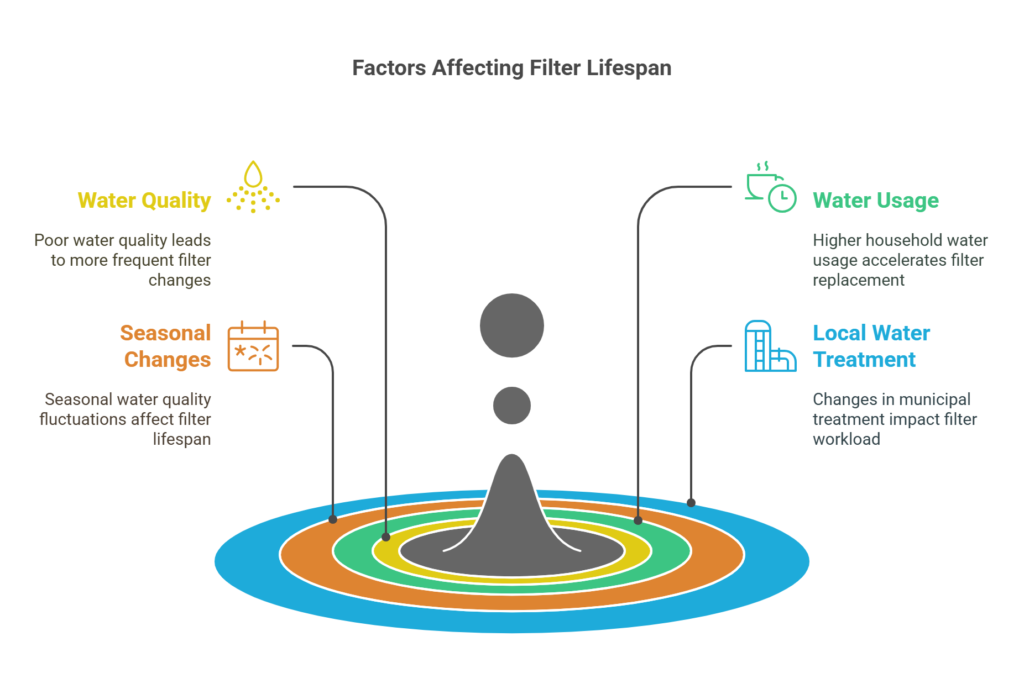
Several variables can impact how often you need to replace your Aquasana filters:
Water Quality
The quality of your source water significantly affects filter performance. If your water is particularly hard or contains high levels of sediment, your filters may need more frequent replacement.
Areas with poor water quality may need filter changes as often as every three to four months.
Water Usage
The amount of water your household consumes directly impacts filter lifespan. A household of two will likely need less frequent replacements than a family of six.
High water usage households might need to replace filters every four months, while low usage homes might stretch to eight months between changes.
Seasonal Changes
Some regions experience fluctuations in water quality throughout the year. For example, spring runoff can introduce more sediment into water supplies, potentially requiring more frequent filter changes during certain seasons.
Local Water Treatment
Changes in your municipal water treatment can affect your filters’ workload. If your local water authority alters it’s treatment processes or sources, it may impact how quickly your filters become saturated with contaminants.
Signs It’s Time for a Change
While the six-month guideline is helpful, it’s crucial to be aware of signs that your filters may need replacement sooner:
Decreased Water Pressure
A significant drop in water pressure throughout your home could indicate clogged filters. As filters become saturated with contaminants, they restrict water flow.
If you notice a gradual decrease in pressure over time, it’s likely time for a filter change.
Changes in Water Taste or Odor
Your water should taste clean and fresh. Any noticeable changes in taste or smell could signal that your filters are no longer effectively removing contaminants.
Pay attention to any chlorine taste or musty odors, as these are common indicators of filter saturation.
Visible Sediment
If you start seeing particles in your water, especially when filling a clear glass, your filters may no longer be effective. This could be a sign that the pre-filter is saturated or that contaminants are bypassing the filtration system entirely.
Increased Utility Bills
Clogged filters can make your water heater and other appliances work harder, potentially increasing your energy costs. If you notice an unexplained rise in your utility bills, it might be worth checking your water filter system.
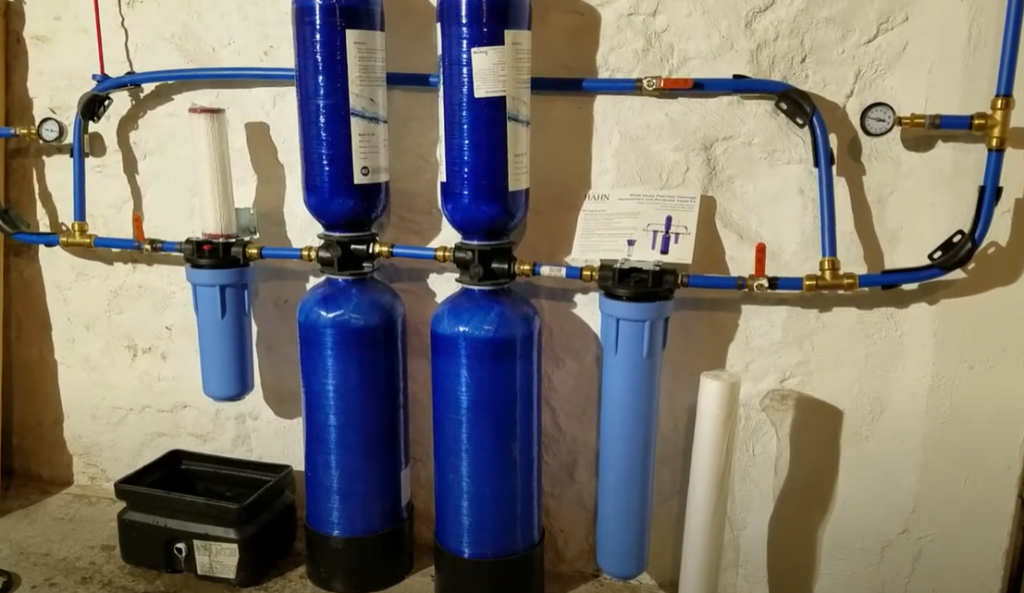
The Consequences of Delayed Replacement
Stretching your filters’ lifespan to save money can lead to several issues:
Reduced Filtration Efficiency
Over time, filters become less effective at removing contaminants. As the filter media becomes saturated, it’s ability to trap new particles reduces, allowing more contaminants to pass through into your water supply.
Bacterial Growth
Old filters can become breeding grounds for bacteria. The moist environment and trapped organic matter create ideal conditions for microbial growth.
This can potentially introduce new contaminants to your water, defeating the purpose of filtration.
System Damage
Clogged filters can strain your plumbing system and water-using appliances. The increased pressure required to push water through saturated filters can lead to leaks, burst pipes, or damage to appliances like washing machines and dishwashers.
Customizing Your Replacement Schedule
While the manufacturer’s recommendation is a good starting point, you can fine-tune your replacement schedule to better suit your specific needs:
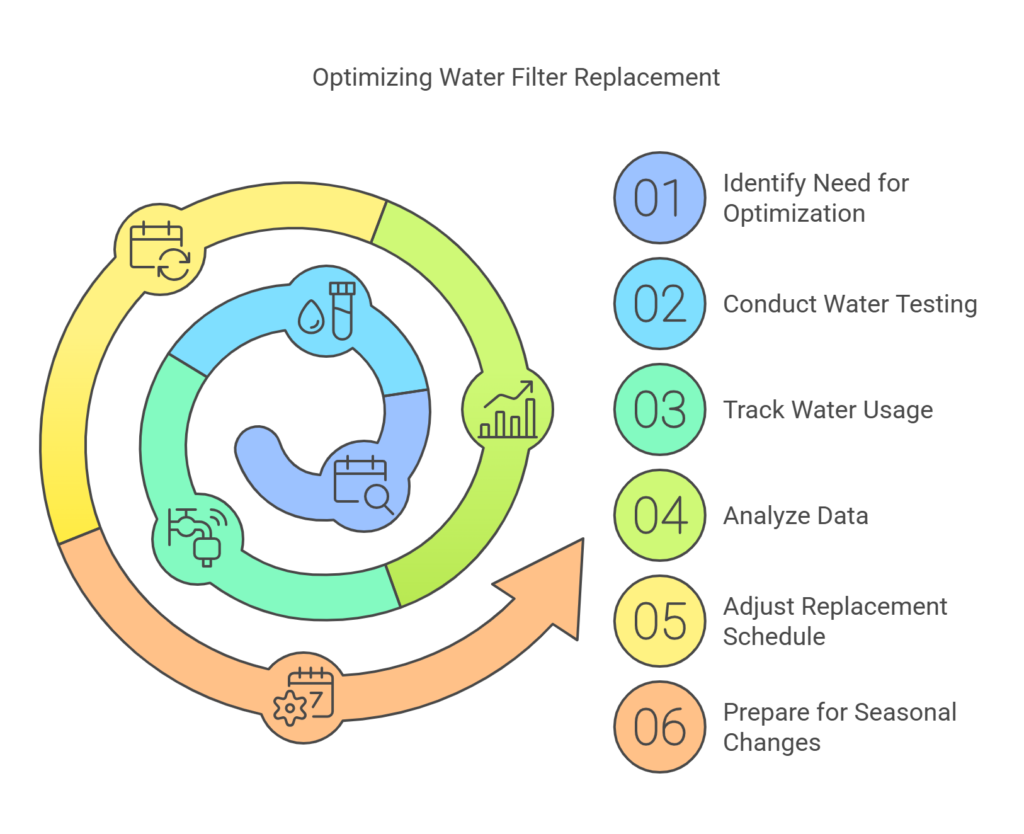
Water Testing
Regular water testing can help you understand how quickly your filters are becoming saturated. Home water testing kits are readily available and can provide valuable insights into your water quality. Consider testing your water every three months to track changes in contaminant levels.
Usage Tracking
Keep a log of your water usage to better forecast when replacements might be needed. Many modern water meters can provide detailed usage data. Alternatively, you can estimate usage based on your water bills.
This information, combined with water quality data, can help you create a more accurate replacement schedule.
Seasonal Adjustments
Be prepared to replace filters more often during seasons when your water quality might be compromised. For example, if you know your area experiences higher sediment levels during spring runoff, plan for an extra filter change during this period.
The Environmental Consideration
As we strive for cleaner water, it’s important to consider the environmental impact of frequent filter replacements. Here are some eco-friendly tips to minimize waste:
Recycling Options
Many filter components can be recycled. Check with your local recycling center for guidelines on how to properly dispose of used filters. Some manufacturers, including Aquasana, offer recycling programs for their products.
Optimizing Replacement Schedules
Fine-tuning your replacement schedule can help reduce waste without compromising water quality. By avoiding premature replacements and not waiting too long between changes, you can maximize filter efficiency and minimize environmental impact.
Sustainable Filter Options
Some Aquasana models offer more sustainable filter options with longer lifespans. Consider upgrading to a system with longer-lasting filters if you find yourself replacing filters often.
DIY vs. Professional Replacement

Replacing your Aquasana filters can be a DIY project for many homeowners. The process typically involves:
- Shutting off the water supply
- Releasing pressure from the system
- Removing the old filter
- Installing the new filter
- Checking for leaks
- Flushing the system
However, if you’re not comfortable with basic plumbing tasks, professional installation confirms proper fitting and can help identify any potential issues with your system. Many plumbers and water treatment specialists offer filter replacement services.
The Importance of Pre-Filter Maintenance
Don’t overlook your pre-filter! This first line of defense catches larger particles and can significantly extend the life of your main filter.
Consider checking and cleaning (or replacing) your pre-filter more often than the main filter.
For many Aquasana systems, the pre-filter can be cleaned as opposed to replaced. A simple backwash or manual cleaning can restore much of it’s functionality. Aim to check your pre-filter monthly, especially if you have high sediment levels in your water.
Adapting to Your Unique Situation
Every household is unique. Your water usage patterns, local water quality, and even your home’s plumbing can all impact how often you need to replace your filters.
Don’t be afraid to experiment and adjust your schedule as needed.
Start by following the manufacturer’s recommendations, but pay close attention to the signs of filter fatigue. Keep a log of when you replace filters and any changes you notice in water quality or pressure.
Over time, you’ll develop a sense of the optimal replacement schedule for your home.
The Role of Water Hardness
Water hardness can significantly impact filter lifespan. Hard water contains high levels of minerals like calcium and magnesium, which can quickly saturate filters.
If you live in an area with hard water, you might need to replace your filters more often.
Consider installing a water softener in addition to your Aquasana system. This can help extend filter life by removing many of the minerals that contribute to filter saturation.
Impact of Chlorine and Chloramines
Many municipal water supplies use chlorine or chloramines for disinfection. These chemicals can quickly degrade filter media, potentially shortening filter life.
If your water supply has high levels of these disinfectants, you might need more frequent filter changes.
Aquasana offers specific filter options designed to handle high chlorine and chloramine levels. Consider upgrading to these if you’re experiencing rapid filter degradation.
The Cost-Benefit Analysis of Filter Replacement
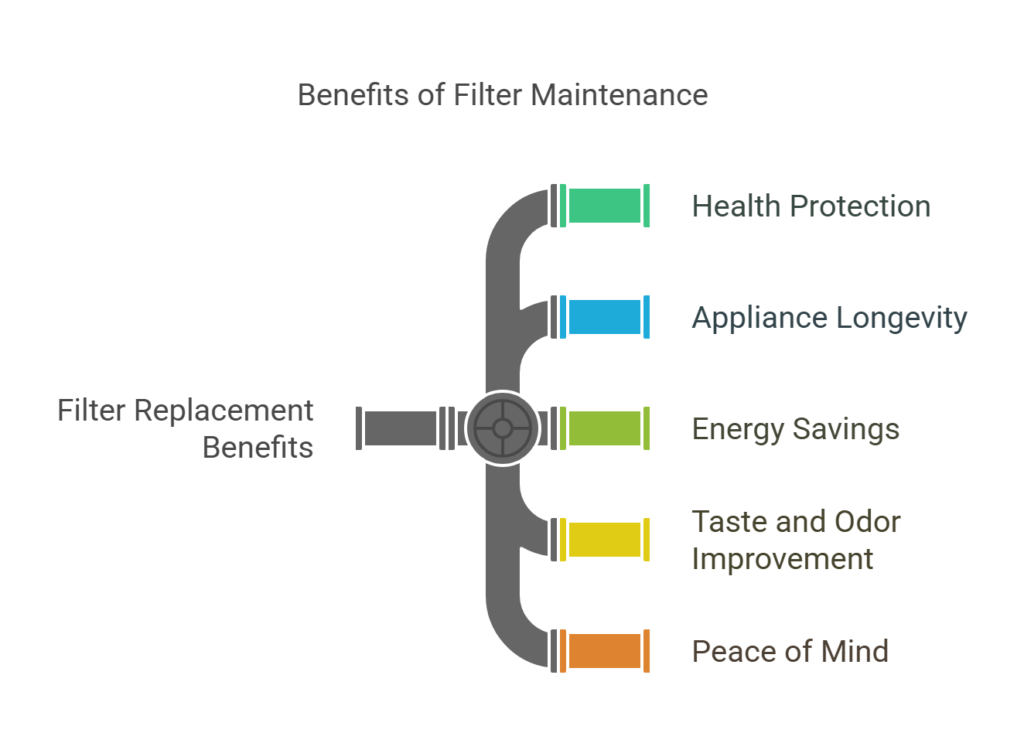
While frequent filter replacements might seem costly, it’s important to consider the long-term benefits:
- Health Protection: Properly maintained filters confirm your family has access to clean, safe water.
- Appliance Longevity: Clean water extends the life of water-using appliances like dishwashers and washing machines.
- Energy Savings: Efficient filtration can reduce the energy needed to heat water and run appliances.
- Taste and Odor Improvement: Fresh filters maintain the pleasant taste and smell of your water.
- Peace of Mind: Knowing your water is properly filtered provides invaluable peace of mind.
When weighing the costs of filter replacement, consider these long-term benefits against the relatively modest expense of regular maintenance.
The Impact of Water Temperature
Water temperature can affect filter performance and lifespan. Hot water can cause some filter materials to break down more quickly, potentially releasing trapped contaminants back into the water supply.
For this reason, most whole-house water filter systems are installed on the cold water line before it enters the water heater. If you’ve noticed your filters degrading quickly, check to confirm they’re not being exposed to hot water.
Understanding Filter Capacity
Aquasana filters are rated for a certain capacity, usually expressed in gallons. For example, a filter might be rated for 600,000 gallons or six months, whichever comes first.
Understanding your household’s water usage can help you decide if you’re likely to reach the gallon limit before the time limit.
To calculate your usage:
- Check your water bill for monthly usage
- Divide by 30 to get daily usage
- Multiply by 180 (6 months) to get your six-month usage
If this number exceeds your filter’s gallon rating, you’ll need to replace it more often than every six months.
Frequently Asked Questions

How do I know if my Aquasana filter needs replacing?
You can tell if your Aquasana filter needs replacing by checking the filter’s lifespan indicator, monitoring changes in water taste or flow rate, and following the recommended replacement schedule in the user manual. If unsure, replace it based on the manufacturer’s suggested timeline
What are the signs that my whole house water filter is not working properly?
The signs that your whole house water filter is not working properly include a noticeable drop in water pressure, unpleasant taste or odor, discoloration in the water, and visible sediment. If you experience any of these, it may be time to inspect or replace the filter.
Can I extend the life of my Aquasana filter by cleaning it regularly?
You cannot extend the life of your Aquasana filter by cleaning it, as these filters are designed for replacement rather than maintenance. Attempting to clean them may reduce effectiveness and compromise water quality.
Are there any specific maintenance tips for Aquasana whole house water filters?
The best maintenance tips for Aquasana whole house water filters include replacing the filters according to the recommended schedule, periodically flushing the system, and checking for leaks or pressure changes. Regular inspections ensure optimal performance and water quality.
How does water usage affect the frequency of filter changes?
The main effects of water usage on the filter change frequency is that increased water usage shortens the lifespan of your filter, requiring more frequent replacements, while lower usage may extend its effectiveness. Always monitor water quality and follow manufacturer guidelines based on your household consumption.
Read our full review of the Aquasana Whole House Water Filter System HERE
